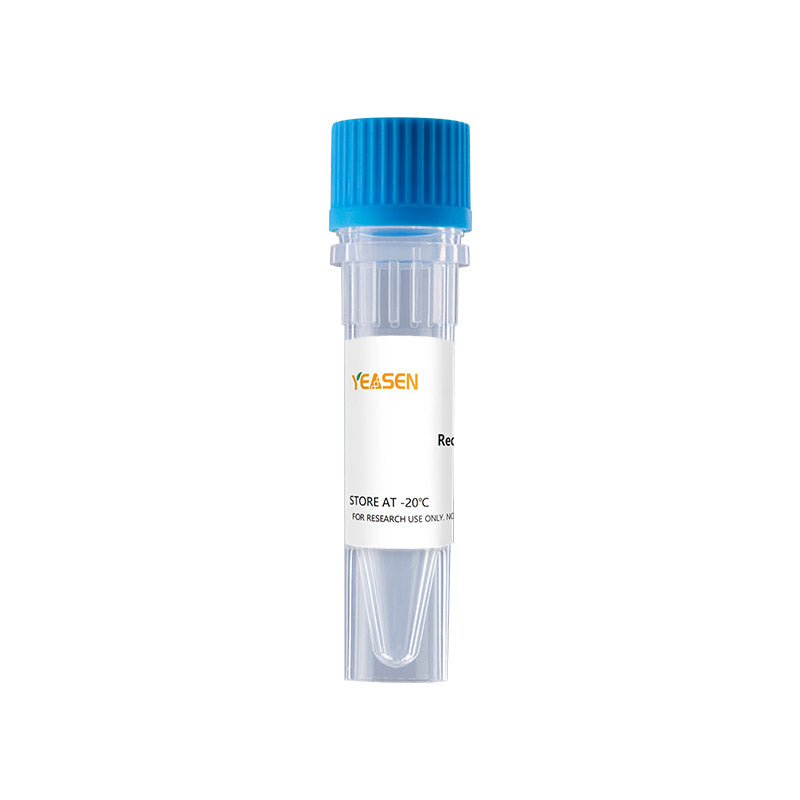Description
FGF basic is a member of the FGF family, currently comprised of seven related mitogenic proteins which show 35 - 55% amino acid conservation. FGF basic has been isolated from a number of sources, including neural tissue, pituitary, adrenal cortex, corpus luteum and placenta. This factor contains four cysteine residues but reduced FGF basic retains full biological activity, indicating that disulfide bonds are not required for this activity. Several reports indicate that a variety of forms of FGF basic are produced as a result of N-terminal extensions. These extensions apparently affect localization of FGF basic in cellular compartments but do not affect biological activity. Studies indicate that binding of FGF to heparin or cell surface heparan sulfate proteoglycans is necessary for binding of FGF to high affinity FGF receptors. FGF acidic and basic appear to bind to the same high affinity receptors and show a similar range of biological activities. FGF basic stimulates the proliferation of all cells of mesodermal origin, and many cells of neuroectodermal, ectodermal and endodermal origin. FGF basic is chemotactic and mitogenic for endothelial cells in vitro. FGF basic induces neuron differentiation, survival and regeneration. FGF basic has also been shown to be crucial in modulating embryonic development and differentiation. These observed in vitro functions of FGF basic suggest FGF basic may play a role in vivo in the modulation of such normal processes as angiogenesis, wound healing and tissue repair, embryonic development and differentiation, and neuronal function and neural degeneration.
Product Properties
|
Synonyms |
FGF-2, HBGF-2 |
|
Accession |
P03969 |
|
GeneID |
281161 |
|
Source |
E.coli-derived Bovine bFGF, Pro10-Ser155, with an N-terminal Met. |
|
Molecular Weight |
Approximately 16.5 kDa. |
|
AA Sequence |
MPALPEDGGS GAFPPGHFKD PKRLYCKNGG FFLRIHPDGR VDGVREKSDP HIKLQLQAEE RGVVSIKGVC ANRYLAMKED GRLLASKCVT DECFFFERLE SNNYNTYRSR KYSSWYVALK RTGQYKLGPK TGPGQKAILF LPMSAKS |
|
Tag |
None |
|
Physical Appearance |
Sterile Filtered White lyophilized (freeze-dried) powder. |
|
Purity |
> 97% by SDS-PAGE and HPLC analyses. |
|
Biological Activity |
The ED50 as determined by a cell proliferation assay using murine balb/c 3T3 cells is less than 0.1 ng/mL, corresponding to a specific activity of > 1.0 × 107 IU/mg. Fully biologically active when compared to standard. |
|
Endotoxin |
< 1.0 EU per 1μg of the protein by the LAL method. |
|
Formulation |
Lyophilized from a 0.2 µm filtered concentrated solution in PBS, pH 7.4. |
| Reconstitution | We recommend that this vial be briefly centrifuged prior to opening to bring the contents to the bottom. Reconstitute in sterile distilled water or aqueous buffer containing 0.1% BSA to a concentration of 0.1-1.0 mg/mL. Stock solutions should be apportioned into working aliquots and stored at ≤ -20°C. Further dilutions should be made in appropriate buffered solutions |
Shipping and Storage
The products are shipped with ice pack and can be stored at -20 ℃ for 1 year.
1 month, 2 to 8 °C under sterile conditions after reconstitution.
3 months, -20 °C under sterile conditions after reconstitution.
Recommend to aliquot the protein into smaller quantities when first used and avoid repeated freeze-thaw cycles.
Cautions
- Avoid repeated freeze-thaw cycles.
- For your safety and health, please wear lab coats and disposable gloves for operation.
- For research use only!
Payment & Security
Your payment information is processed securely. We do not store credit card details nor have access to your credit card information.
Inquiry
You may also like
FAQ
The product is for research purposes only and is not intended for therapeutic or diagnostic use in humans or animals. Products and content are protected by patents, trademarks, and copyrights owned by Yeasen Biotechnology. Trademark symbols indicate the country of origin, not necessarily registration in all regions.
Certain applications may require additional third-party intellectual property rights.
Yeasen is dedicated to ethical science, believing our research should address critical questions while ensuring safety and ethical standards.

